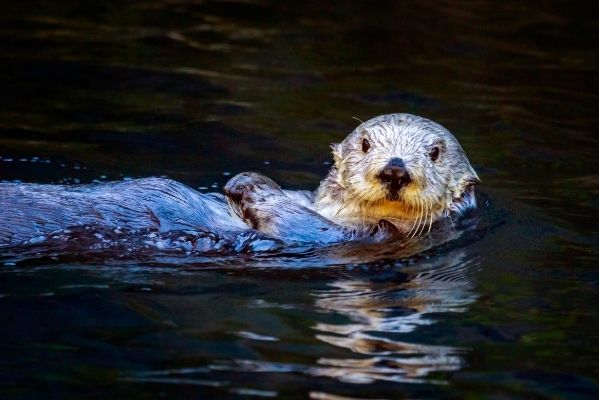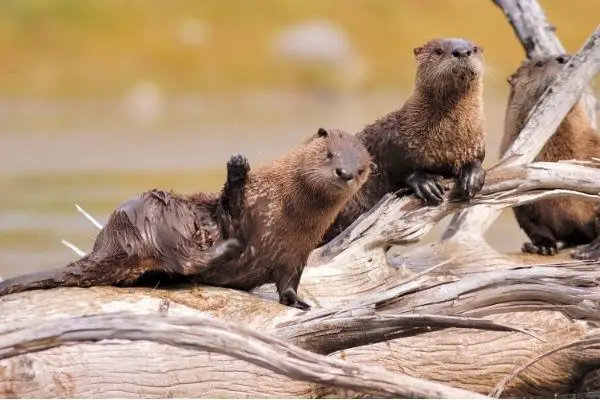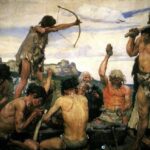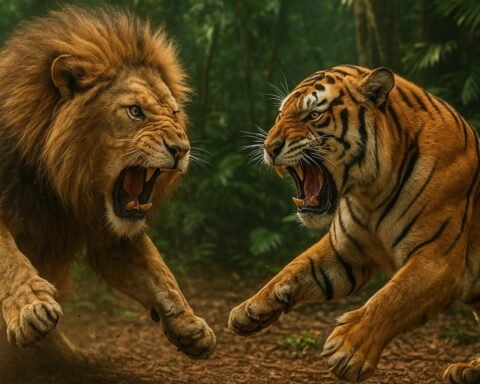Sea Otters are regarded as keystone species, as they play a vital role in keeping their ecosystem balanced. Without them, the ecosystem will collapse. Being a keystone species, they are very interesting to study. We have listed down complete Sea Otter Facts for Kids that will help you in learning all about Sea Otters. You are going to learn about its scientific name & classification, evolution, appearance, physical features, physical abilities, diet, habitat, lifespan, reproduction, babies, behavior, adaptations, food chain, ecological role, endangerment, population, predators, and many other interesting facts about Sea Otters.
Sea Otter Facts For Kids
What is a Sea Otter
- The sea otter is a marine mammal indigenous to the eastern and northern coasts of the North Pacific Ocean.
- It belongs to the weasel family Mustilidae and is the heaviest member of this family.
- In North America, Sea otters are among the smallest marine mammals.
- The most distinguishing feature of the sea otter is its exceptionally thick coat of fur, which is densest in the Animal kingdom.
- Sea otters can live exclusively in the ocean, however, they can walk on the land.
- The population of the sea otter dramatically declined from the mid-1700s to 1911 due to their excessive hunting for the fur trade.
- Their population is still not recovered to a proper level, that is why the IUCN Red List listed it as an Endangered species.

Scientific Name of Sea Otter
- The scientific name of the sea otter is Enhydra lutris.
Scientific Classification Of Sea Otter
- The following is the scientific classification or taxonomy of the sea otter:
| Kingdom | Animalia |
| Phylum | Chordata |
| Subphylum | Vertebrata |
| Class | Mammalia |
| Order | Carnivora |
| Superfamily | Musteloidea |
| Family | Mustelidae |
| Sub-family | Lutrinae |
| Genus | Enhydra |
| Species | Enhydra lutris |
Evolution
- Genetic analysis indicated that about 5 million years ago, the sea otter shared a common ancestor with its closest living relatives (European otter, the oriental small-clawed otter, African clawless otter, and African speckle-throated otter).
- Fossil evidence reveals that approximately 2 million years ago, the isolation of the Enhydra lineage occurred in the North Pacific and gave rise to Enhydra macrodonta (which is now extinct) and Enhydra lutris (sea otter).
- The evolution of the modern sea otter occurred initially in Russia and northern Hokkaido. They then dispersed down the North American coast, east to the Aleutian Islands, and mainland Alaska.
- In 2017, the complete genome of the northern sea otter (Enhydra lutris kenyoni) was sequenced, which may allow revealing the evolutionary divergence of the sea otter from terrestrial mustelids.
What Does Sea Otter Look Like
Appearance
- The sea otter is the smallest marine mammal with a body length of 1.0 to 1.5 meters.
- The body of sea otters is covered with thick and dense fur throughout the year.
- Underwater, their body is long and streamlined with forelimbs closely pressed against the chest.
- Sea otters have long, widely flattened, and webbed hind feet. On every hindfoot, the 5th digit is the longest that facilitates swimming while laying on their back.
- The forepaws are short, have thick pads on the palms, and retractable claws are used to grip and catch slippery prey.
- The tail is short, muscular, thick, and a little flattened.
- It has a slightly elongated head with small ears, eyes, and nostrils.
- Sea otters have a flattened mouth with 32 teeth arranged in the upper and lower jaws. Their dental formula is 3.1.3.1 / 2.1.3.2. They have rounded and flattened molar teeth suited for crushing food rather than cutting. Like seals, they have two pairs of lower incisors.
- Sea otters have long whiskers around their mouth, which are highly sensitive and used to find prey in dark and murky waters.
- The sea otter is a sexually dimorphic species and male individuals are usually bigger than females.

Color
- The usual fur color of sea otters is deep-brown with patches of silver-gray color.
- The range of coloration will be grayish or yellowish-brown to nearly black.
- The head, throat, and chest of adult individuals have light white-yellow or white-brown color.
Physical Features of Sea Otter
Weight
- The body weight of male sea otters ranges from 22 to 45 kg (49 to 99 lbs). The recorded heaviest specimen was up to 54 kg (119 lbs).
- The bodyweight of females ranges from 14 to 33 kg (31 to 73 lbs).
Length
- Sea otters have sexual dimorphism and males usually have larger body size and weight than females.
- The body length of male sea otters ranges from 1.2 to 1.5 meters (3.9 to 4.9 feet).
- The body length of females ranges from 1.0 to 1.4 meters (3.3 to 3.6 feet).
Physical Abilities of Sea Otters
Speed
- Sea otters can run on the land at a speed of about 46.6 km/h (29 mph).
- This ability is essential to avoid some predators like alligators and coyotes.
Jump
- Sea otters can jump vertically high.
- A sea otter in Alaska was observed jumping to a boat and saving himself from a group of killer whales.
Climb
- Sea otters often climb the lower parts of boats.
- Some sources say that they can also climb sloping trees.
Swim
- The sea otter is a marine mammal and an excellent swimmer.
- It moves its hind feet, tail, and whole ending part of its body up and down to propel itself underwater.
- A sea otter can swim at a speed of 9 km/h (5.6 mph).
- Sea otters can dive at the depth of 90 meters (300 feet), however, they usually forage in shallow waters at the depth of fewer than 18 meters (60 feet).
- They can hold their breath for about 5 minutes, however, their diving duration is usually only 2 minutes or less.
What do Sea Otters Eat
Diet
-
In wild
-
- Sea otters eat many invertebrate species, such as sea urchins, abalones, clams, snails, crabs, sea stars, octopuses, and squids, etc.
- They store collected food in the loose skin pouch with their chest and bring it to the surface.
- Their pouch also holds a rock, which they use to break open clams and shellfish.
- Sea otters eat the collected food while floating on their back. They tear food apart with their forepaws and bring it to their mouth.
- Small mussels are chewed and swallowed along with shells while large mussels may be twisted to open apart.
- Meat in shellfish is obtained by using their lower incisor teeth.
- Sea otters eat large sea urchins, which is their most favorite food. As sea urchins are covered with spines, they bite the underside where the spines are shorter and lick the soft material out of the urchin shell.
- Sea otters spend about 24 to 60% of their daytime foraging. However, it depends mostly on the availability of prey.

-
In captivity
-
- In captivity, sea otters are fed with shrimps, surf clams, and squids.
-
List of food items
-
- Sea urchins
- Shellfish
- Mussels
- Clams
- Snails
- Abalones
- Fish
- Fat innkeeper worms
- Squids
- Crabs
- Octopus
- Sea stars
- Frogs
- Other small land vertebrates (such as frogs) and eggs
How much Sea Otters eat per day
- As sea otters have a high metabolic rate, their daily food requirement is equal to 25 to 38% of their whole body weight.
- So a sea otter of 25 kg weight needs about 6 to 9 kg of food per day.
What does baby Sea Otter eat?
- Baby sea otters eat mother’s milk for six to twelve months.
- The milk of sea otters is rich in fats and resembles the milk of other marine mammals rather than mustelids.
- At the age of one to two months, mothers also offer them bites of prey.
Where do Sea Otters Live – Sea Otter Habitat
Natural Habitat
- Sea otters are indigenous to the northern and eastern coastal regions of the North Pacific Ocean.
- The natural habitat of sea otters is 50 to 75 feet (15 to 23 meters) deep coastal temperate waters.
- They usually reside within a kilometer of the shore.
- They are mostly found in the regions naturally secure from severe winds of the ocean, such as thick kelp forests, barrier reefs, and rocky coastlines.
- Sea otters have a very strong association with rocky substrates, however, they can also live in regions where the seafloor is of sand, mud, or silt.
- Sea otters can survive in waters with drift ice, however, they can not survive amidst land-fast ice.
- The home range of individual sea otters is generally a few kilometers long where they stay throughout the year.
Biome
- Sea otters live in the aquatic biome.
- While the type of their aquatic biome is coastal.
- Range
The habitat range of sea otters includes two geographic regions on the North Pacific coast:
- Along the eastern regions of the North Pacific Ocean, which include the central coast of California from Ano Nuevo to Point Sur.
- Along the northern regions of the North Pacific Ocean, which includes the Kuril and Commander Islands off the Russian coast, the Aleutian Islands below the Bering Sea, regions off the coast of Alaska Peninsula to Vancouver Island, and Canada.
- Their northern range is limited by sea ice to below 57 ° N latitude, while their southern range is limited by kelp forests to about 22 ° N latitude.
Countries List
- The habitat range of sea otters is located in the following countries:
- Japan
- Russia
- Canada (British Columbia)
- United States (Alaska, Washington, Oregon, California)
- Mexico (Baja California)
Sea Otter Lifespan
In Wild
- The lifespan of male sea otters in the wild ranges from 10 to 15 years and of females from 15 to 20 years.
- The maximum lifespan in the wild is 23 years.
In Captivity
- In captivity, sea otters mostly live for about 20 years.
- A female individual at the Seattle Aquarium lived for 28 years.
Sea Otter Life Cycle
- The life cycle of a sea otter starts when it is born after a gestation period of 4 to 12 months.
- Male sea otters attain sexual maturity at the age of about 5 years while females at the age of 3 to 4 years.
- At this age, they often do not successfully reproduce until they become more mature after a few years.
- Male find a female mate and start breeding.
- Usually, a single pup is born after a gestation period of 4 to 12 months.
- Sea otters live for a maximum age of 23 years in the wild, while for a maximum age of 28 years in captivity.
Sea Otter Reproduction
- Sea otters are polygynous, which means male individual mates with many female partners.
- They reproduce throughout the year.
- The male partner often bites the female at the muzzle during mating.
- The gestation period ranges from 4 to 12 months, as the sea otters can delay zygote implantation (embryonic diapause) after 4 months of pregnancy.
- In the Aleutian Islands, the births are at a peak between May and June. While in California, the births are at peak between January and March.
- The birth of the baby usually occurs in the water.
- Sea otters usually give birth to only a single pup. Twins are rare and occur only 2% in births, in which only one pup usually survives.
- Mothers take care of the pups and are also observed sometimes taking care of the orphaned pups.
Sea Otter Baby
- The baby sea otter is known as a pup.
- Newborn pups usually weigh 1.4 to 2.3 kg (3 to 5 lbs).
- They are born with open eyes and have 10 visible teeth.
- Their bodies are covered with a thick coat of baby fur.
- Mothers have observed fluffing and licking newborn pups for hours.
- Due to the grooming of the mother, the fluffy fur of the baby retains so much air that it can float on the water surface like a cork and do not sink.
- At the age of about 13 weeks, adult fur replaces fluffy baby fur.
- In Alaska, mothers nurse the babies for 4 to 12 months, while for 6 to 8 months in California. At the age of 1 to 2 months, mothers start to offer them bits of the prey.
- Mother guides a pup and practices his swimming and diving for several weeks until it becomes able to reach the seafloor.
- At the age of 6 to 8 months, the pups become juveniles and are typically independent at this age. In some cases, a mother is forced to abandon her pup if she is unable to find enough food for him. In other cases, pups are nursed until they attain adult size.
- The mortality rate of pups is high, especially during the first winter of their life. It is estimated that only 25% of pups survive till their first birthday.
- Females attain sexual maturity at the age of about 3 to 4 years, while males at the age of about 5 years.
Sea Otter Male vs Female
- Male sea otters have relatively larger body sizes and weights than females. They do not take part in raising babies.
- Female sea otters fulfill all the tasks of feeding and raising babies. She gives constant attention to her infant and cradles it on her chest to keep him away from the cold water. She also attentively grooms its fur to avoid any risk of its sinking. When going to forage, the mother leaves her baby floating on the water. She also sometimes wraps her baby in kelps to avoid him from floating away. When the baby is not sleeping, he cries with a loud voice until his mother returns.
- Sea otter mothers are known to carry their dead babies on their chests for days.
How Do Sea Otters Protect Themselves
- Sea otters protect themselves from predators through; escaping, taking shelter in kelps where they live, and going on the land.
- In case of interaction with other sea otters, it uses its strong teeth and claws for fighting.
Behavior Of Sea Otter
- Sea otters are diurnal in nature. Their foraging and eating time starts in the morning an hour before sunrise. In mid-day, they sleep or rest and then restart foraging in the afternoon that continues till the sunsets. They may also have a third foraging period at the midnight.
- The sea otter is included in a few mammal species that can use tools. It uses rocks while hunting and feeding. To open the hard shells of shellfish or clams, they repeatedly smash it against a rock on its chest. They also use rock as a hammer to pry an abalone off its rock. They are observed blowing 45 times in just 15 seconds to release the abalone.
- Sea otters groom themselves by cleaning their fur, removing loose fur, untangling the knots, and rubbing their fur with their front paws to squeeze out water and blow air into their fur. When eating, sea otters frequently roll in water, perhaps to wash out food scraps from their fur.
- All juvenile and adult sea otters forage independently, however, they rest in groups known as rafts. The groups are single-sex and have only males or females. Usually, a raft has 10 to 100 individuals. Male rafts are usually larger than female rafts. The recorded largest raft had over 2,000 individuals. To avoid drifting out to sea, they wrap themselves in giant seaweeds or kelps.
- Male sea otters are territorial and maintain breeding territory. They usually protect their territory from spring to autumn, which is their peak breeding season. They patrol their territory during that time to keep other males away. Individuals with no territory tend to congregate in male-only groups and swim through the area of females to search for a mate.
- Sea otters make several sounds. The cry of a sea otter’s pup resembles the sound of a seagull. When content, males grunt while females make soft murmuring sounds. When frightened or distressed, adult sea otters may hiss, whistle, or even scream in extreme situations.
Sea Otter Adaptations
Physical Or Structural Adaptations
-
Thick and Dense Fur
-
- Sea otters have the thickest and densest fur of all animals with about 850,000 to 1000,000 hairs per square inch.
- Having such exceptional fur is an important adaptation because they do not have blubber (a layer of fats beneath the skin that exists in most marine mammals) and depend exclusively on their fur for insulation.
- Their fur consists of two layers; a short underfur, and long guard hair. The guard hairs are waterproof and keep the underfur layer dry. In such a way, cold water does not contact the skin of sea otters and reduces heat loss.
- Their fur also remains thick throughout the year. The hair is gradually shed and replaced rather than in a special molting season.
-
Loose Skin And Flexible Bones
-
- Sea otters have loose skin and flexible bones.
- It is also an important adaptation because the waterproofing ability of guard hairs depends on extreme cleanliness.
- Loose skin and flexible bones make sea otters able to clean and groom every part of their body.
-
Closable Ears and Nostrils
-
- Sea otters have small ears and nostrils, which they can close.
- It not only protects water from entering their body but also reduces heat loss.
-
Long and Webbed Hind Feet
-
- Sea otters have long, flattened, and webbed hind feet well-adapted for swimming.
- During swimming, their hind feet provide most of the propulsion in water.
-
Elongated 5th Digit On Hind Feet
-
- Each hind foot of sea otters has an elongated fifth digit.
- This digit facilitates swimming while they are on their backs.
-
Front Paws
-
- The front paws of sea otters are short and equipped with retractable claws while having tough pads on the palms.
- Their paws are well-adapted and provide a strong grip to catch slippery prey, such as fish.
-
Long Whiskers
-
- Sea otters have long and extremely sensitive whiskers.
- It uses its whiskers along with its front paws to find prey through its sense of touch in murky and dark water.

Physiological Adaptations
-
Dense bones
-
- The bones of sea otters show osteosclerosis, which means their bones are harder and have a high density.
- Having such bones is an important marine adaptation, which reduces buoyancy and helps them to stay in the water.
-
Large Lung Capacity
-
- The lung capacity of sea otters is about 2.5 times greater than the land mammals of their size.
- It makes their body extremely buoyant along with the air trapped in their fur and protects them from sinking.
-
High Metabolism Rate
-
- The metabolism rate of sea otters is 2 to 3 times higher than the of terrestrial mammals of similar size.
- So they must eat food equal to 25 to 38% of their body weight every day.
- Eating so much food is necessary for them to burn calories and to maintain average body temperature to counteract the heat loss due to living in cold waters.
-
Large Kidneys
-
- Unlike most marine mammals, sea otters drink seawater.
- Their large kidneys are specially adapted to derive fresh water from the salted seawater and excrete concentrated urine.
Sea Otter Food Chain
- In the food chain of sea otters, the sun is the overall source of energy.
- Sea otters are part of the marine ecosystem, so marine vegetation like kelps are producers that get energy from the sun and prepare food through photosynthesis for themselves.
- Primary consumers in this food chain are sea urchins and many other marine invertebrates that feed on marine vegetation.
- Secondary consumer is the sea otter that eats sea urchins and many other species of marine invertebrates and fish.
- Tertiary consumers are the predators of sea otters, which include orca, great white shark, bald eagle, bears, and coyotes.
Ecological Role of Sea Otter
- Sea otters are a keystone species, and their presence extremely affects the ecosystem regardless of their size and number.
- They keep the population of certain herbivore animals found on the seafloor in control, especially the sea urchins.
- Sea urchins eat the lower stems of kelp and cause its destruction.
- Regions of the North Pacific with no sea otters often have abundant sea urchins and lack kelp forests. Kelp forests are extremely necessary for the ecosystem, as they absorb and capture CO₂ and use it in photosynthesis.
- In British Columbia, the reintroduction of sea otters caused a considerable improvement in the health of the coastal ecosystem.
- Sea otters also influence the rocky ecosystem, which has mussels beds. Sea otters remove mussels from the rocks and allow space for other competing species. So they play a role in increasing species diversity.
Population
- Between 2004 and 2007, the estimated worldwide population of sea otters was about 107,000 individuals.
Why Are Sea Otters Endangered
Reasons
The major reasons for the sea otters endangerment are:
- Excessive Hunting of sea otters for the fur trade that started in the mid-1700s and ended in 1911 caused the near extinction of the sea otters.
- Sea otters were hunted for their fur, which had extremely high value due to their thickness and insulating qualities. The pelt of a sea otter sold for as much as $1,125. Their skin was used in making coats, hats, and other garments sold in Russia, Japan, the United States, and Canada. In 1911, the USA, Japan, Russia, and Great Britain signed an agreement known as the International Fur Seal Treaty and banned the hunting of all fur-bearing marine mammals.
- Diseases (parasitic and infectious) also contribute to the mortality of sea otters.
- An oil spill in 1989 (Exxon Valdez oil spill) killed about 5,000 sea otters in Alaska.
Conservation status
- The conservation status of the sea otter on the IUCN Red List as Endangered.
Sea Otter Predators
- The major mammalian predators of sea otters are sea lions and orcas (killer whales).
- Bald eagles are known to grab the sea otter pups from the water surface.
- The great white shark is the primary predator of sea otters in California.
- Coyotes and bears are the major land predators of the sea otters and attack their pups.
Fun Facts About Sea Otters
- The sea otter is the only member of the genus Enhydra and no other species exists in this genus.
- The sea otter is one of the few mammal species that use tools.
- The fur of the sea otter is the densest and thickest in the animal kingdom.
- The estimated number of hairs per square inch on the sea otter’s coat is 850,000 to 100,000.
- Sea otter is one of the smallest marine mammals, however, it is the heaviest member of the weasel family Mustelidae.
- Several features make sea otters unique from other mustelids, such as having no functional scent glands, not making burrows or dens, and the ability to spend their whole life in water.
- Unlike most marine mammals, sea otters do not have a thick layer of fats beneath their skin (blubber) and depend on their exceptionally thick fur for insulation.
- The sea otter is so different from other members of the Mustelidae family that some scientists recently believed that it may be closely related to the earless seals.
- Sea otters are the only marine mammals that do not use their teeth to catch prey, but rather use their front paws.










